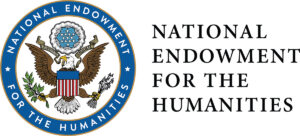by Rebecca Furer for Teach It
TEACHER'S SNAPSHOT
Subjects:
Belief & Religion, Civics, Colonial History, Law, Politics & Government
Course Topics/Big Ideas:
Democratic Principles and the Rule of Law, The Struggle for Freedom, Equality, and Social Justice
Grade:
High School
Lesson Plan Notes
There was no separation of church and state in early Connecticut. Blasphemy and worship of “any other God but the Lord God” were listed as capital offenses in the Code of 1650. Parents and masters were required by law to provide their children or apprentices with religious education. Under the Fundamental Orders of 1639, the governor had to be a member of an “approved Congregation,” although voters were not required to be church members in Connecticut Colony (as they were in New Haven Colony at the same time.)
The Congregational Church was the established, official church of the colony. The church even oversaw local schools until 1795. All residents were expected to pay taxes to their local Congregational Church, whether or not they worshiped there. In 1727, the General Assembly passed a law exempting members of the Anglican Church from paying taxes to the Congregational Church and allowing their taxes to be delivered to their local minister instead. Later laws exempted members of other Christian denominations from paying taxes to the “established Society,” as long as they filed a certificate declaring that they attended a dissenting church and contributed to it financially.
By 1790, about two-thirds of the religious societies in the state were Congregationalist, while the other one-third represented other Christian denominations (mostly Anglican/Episcopalian and Baptist.) Jewish congregations were not allowed to incorporate in Connecticut until 1843. The Congregational Church was disestablished in the Connecticut Constitution of 1818, nearly two decades after the First Amendment to the United States Constitution banned Congress from making any law “respecting an establishment of religion.”
ESSENTIAL QUESTION
SUPPORTING QUESTIONS
- Was there religious freedom in colonial Connecticut?
- What was the relationship between church and state in early Connecticut (1639-1818)?
- Who were some of the people/groups advocating for a separation of church and state in early Connecticut?
- To what extent were there successful challenges to the establishment of the Congregational Church in Connecticut prior to 1818?
- What effect did the Constitution of 1818 have on the relationship between church and state in Connecticut?
- Is there religious freedom in Connecticut today? In the United States?
- To what extent is there a separation of church and state today?
ACTIVITY
- You may choose to have all students in the class examine all of the documents in the toolkit over several sessions, or you may divide the students into five groups, having each group focus on one document set.
- Introduce the compelling question and assign the primary source documents that will drive the inquiry.
- Use the Library of Congress Primary Source Analysis Tool worksheet (download Teacher’s Guide) or another technique or organizer of your choice to guide students’ observations, reflections, and generation of questions.
- Have students share their discoveries and questions based on the document set they have just explored. You may also want to introduce some of the suggested supporting questions listed above.
- As students investigate additional sources or hear from other groups, return frequently to the list of questions.
- Conclude with a discussion of the compelling question—supported by evidence from the primary sources—and a recap of any unanswered questions and what additional resources might exist.
OPPORTUNITIES FOR ASSESSMENT
- Students will research the history of the relationship between church and state in a different colony or region of the United States and compare it to the situation in Connecticut.
- Students will investigate contemporary issues relating to the separation of church and state or religious freedom in the United States or elsewhere in the world. These could include school prayer; public monuments that are religious in nature; school vouchers; religious profiling; bans on niqabs, burkas, or headscarves; government funding for faith-based organizations or programs; immigration policy; religious persecution worldwide; etc.
RESOURCE TOOL KIT
Document Set #1:
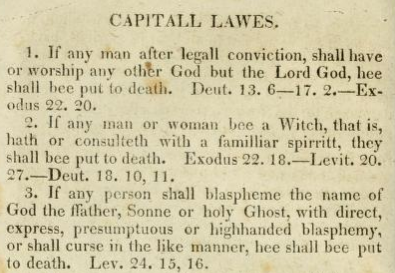
“Capitall Lawes.” Published in The Code of 1650, Being a Compilation of the Earliest Laws and Orders of the General Court of Connecticut: Also, the Constitution, or Civil Compact, Entered into and Adopted by the Towns of Windsor, Hartford, and Wethersfield in 1638-9. To Which is Added Some Extracts from the Laws and Judicial Proceedings of New Haven Colony Commonly Called Blue Laws. Hartford, 1830. p. 28-29. Original from University of California.
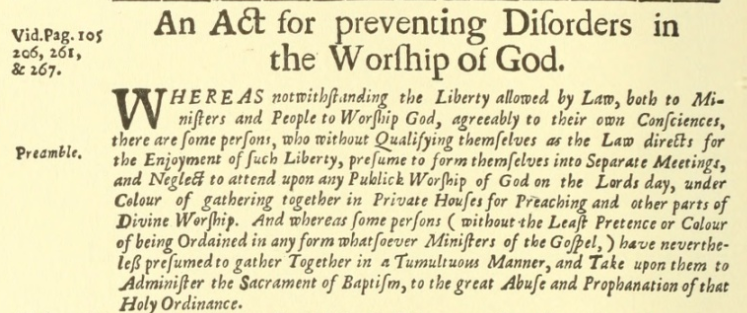
“An Act for preventing Disorders in the Worship of God.” May, 1723. Published in Acts and Laws, of His Majesties Colony of Connecticut in New-England: Passed by the General Assembly May 1716 to May 1749. Hartford, 1919. p. 290. Original from University of California.
Document Set #2:
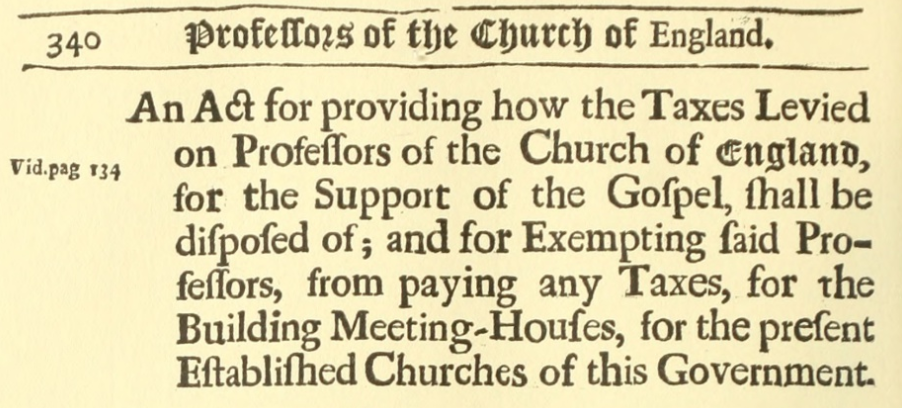
“An Act for providing how the Taxes Levied on Professors of the Church of England, for the support of the Gospel, shall be disposed of….” May, 1727. Published in Acts and Laws, of His Majesties Colony of Connecticut in New-England: Passed by the General Assembly May 1716 to May 1749. Hartford, 1919. p.340. Original from University of California.
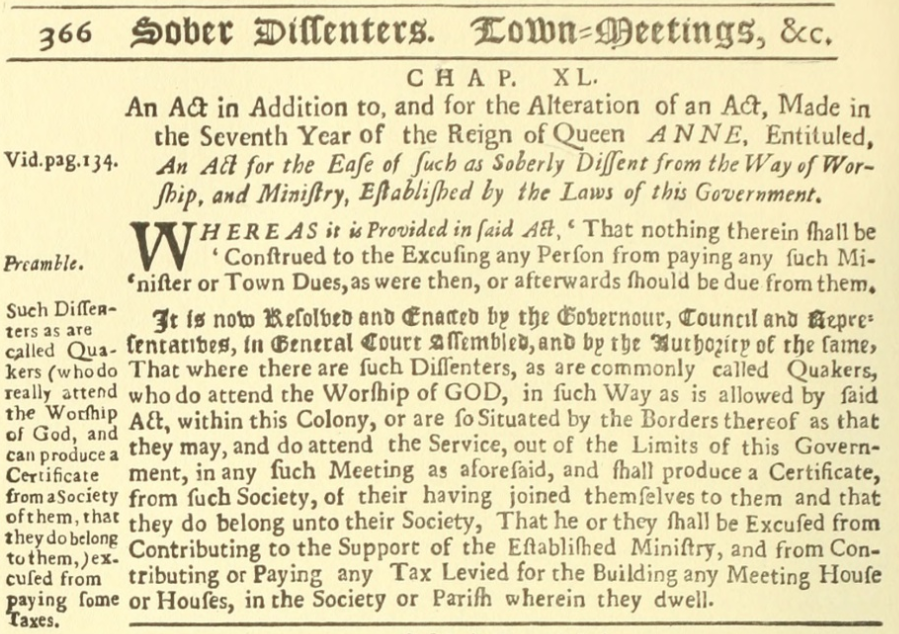
“An Act in Addition to, and for the Alteration of an Act… for the Ease of Such as Soberly Dissent from the Way of Worship, and Ministry, Established by the Laws of this Government.” May, 1729. Published in Acts and Laws, of His Majesties Colony of Connecticut in New-England: Passed by the General Assembly May 1716 to May 1749. Hartford, 1919. p.366. Original from University of California.
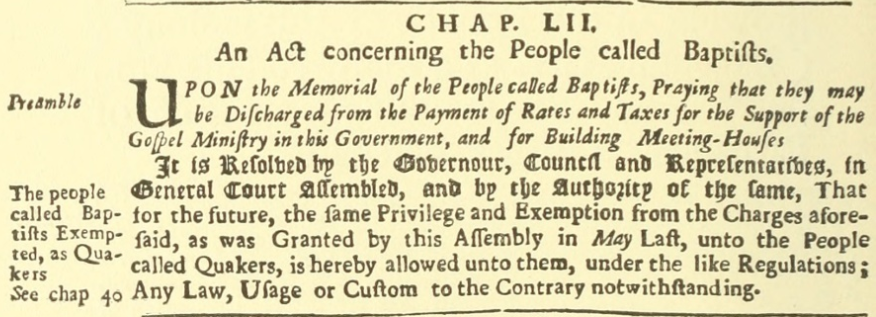
“An Act concerning the People called Baptists.” October, 1729. Published in Acts and Laws, of His Majesties Colony of Connecticut in New-England: Passed by the General Assembly May 1716 to May 1749. Hartford, 1919. p. 372. Original from University of California.
Document Set #3:

“An Act securing equal Rights and Privileges to Christians of every denomination in this State.” Enacted in October 1791. Published in Public Statute Laws of the State of Connecticut, Book I, Hartford, 1808. p. 575. Original from New York Public Library.
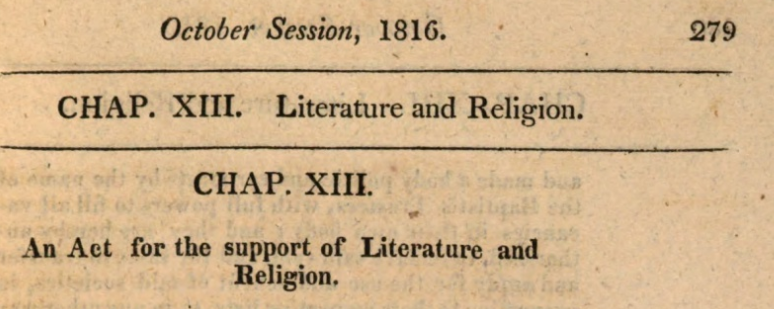
“An Act for the Support of Literature and Religion.” October 1816. Published in Public Statute Laws of the State of Connecticut, Book II, Hartford, 1808. p. 279. Original from New York Public Library.
Document Set #4:
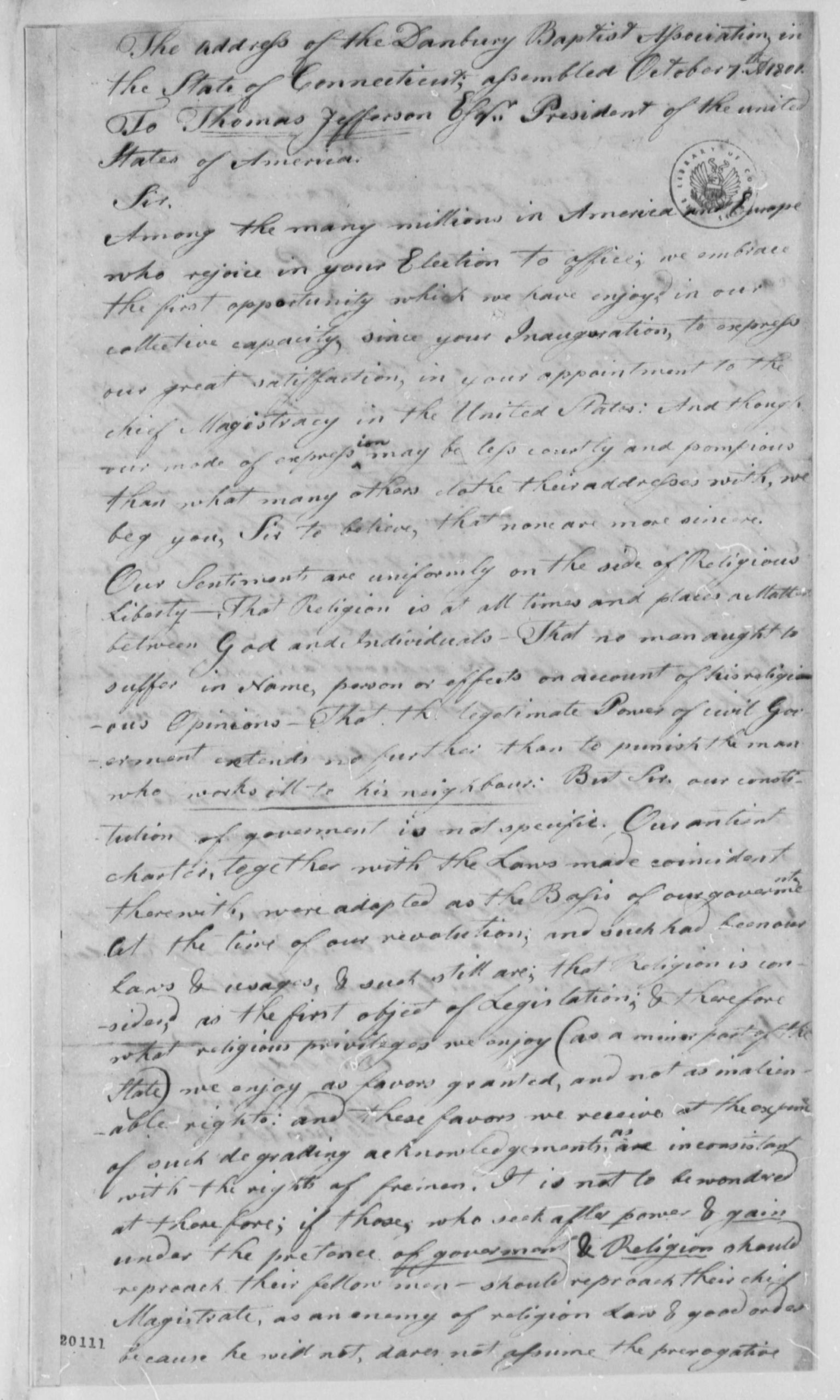
Danbury, Connecticut, Baptist Association to Thomas Jefferson, October 7, 1801. The Thomas Jefferson Papers at the Library of Congress.
You can view a transcription online, courtesy of The Thomas Jefferson Papers, Princeton University.
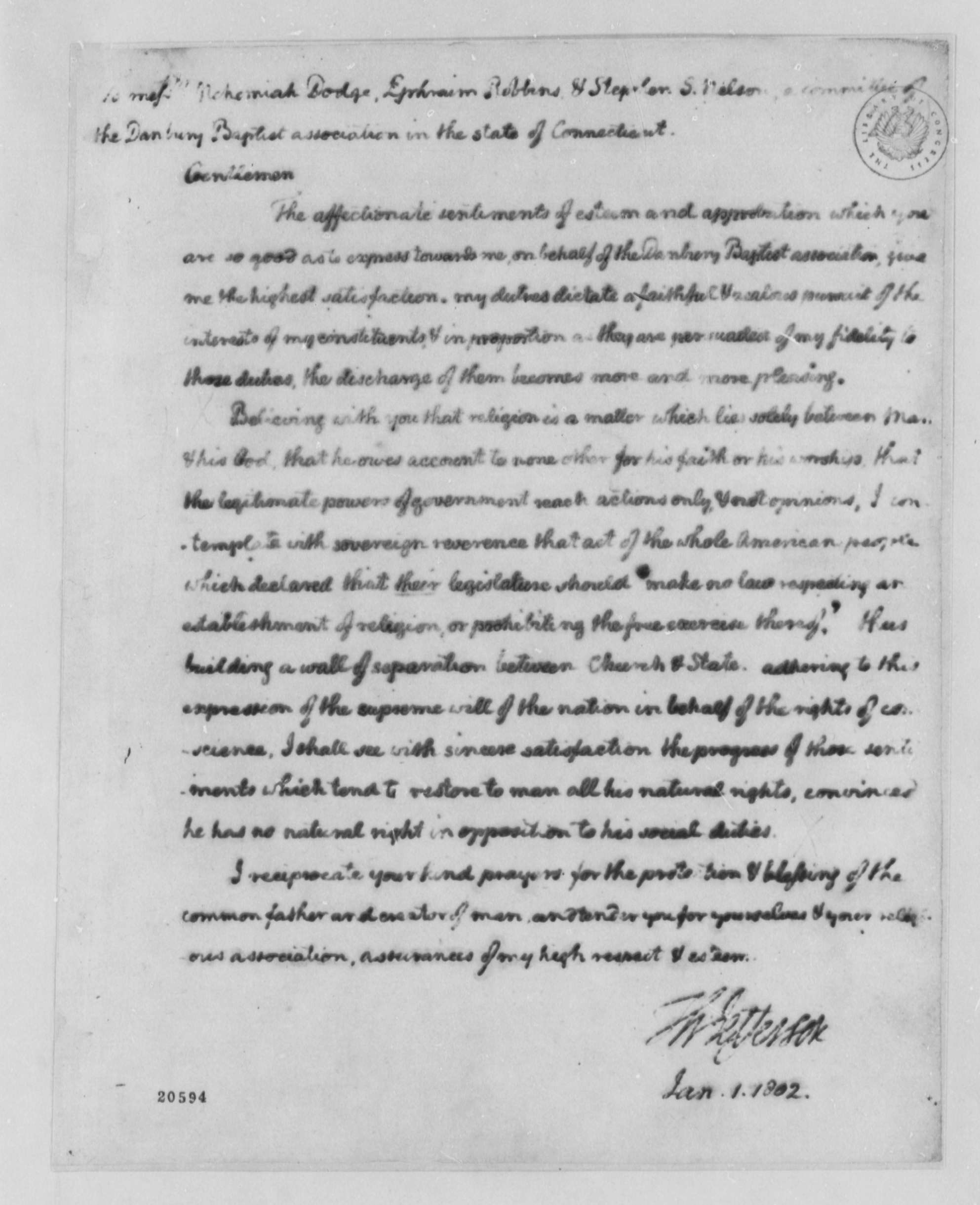
Thomas Jefferson to Danbury, Connecticut, Baptist Association, January 1, 1802. Image 2 (Copy). The Thomas Jefferson Papers at the Library of Congress.
You can view a transcription online, courtesy of The Thomas Jefferson Papers, Princeton University.

Transcription of Danbury, Connecticut, Baptist Association to Thomas Jefferson, October 7, 1801, and Thomas Jefferson to Danbury, Connecticut, Baptist Association, January 1, 1802.
Document Set #5:
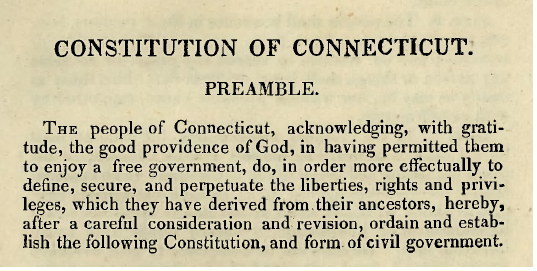
Constitution of Connecticut, 1818. Article I: Declaration of Rights, especially Sec. 3-4; Article VII: Of Religion – Connecticut State Library Digital Collections.
Analysis Worksheet:

Library of Congress Primary Source Analysis Tool Worksheet
ADDITIONAL RESOURCES
Places to GO
Museum of Connecticut History, where you can see some of Connecticut’s founding documents.
Things To DO
Explore more! Read the Election Sermon preached by Rev. Harry Croswell on May 14, 1818. Selected by newly-elected Governor Oliver Wolcott Jr., Croswell, an Episcopalian, was the first non-Congregationalist to preach this annual sermon in Connecticut. His sermon on the biblical verse, “Render, therefore, unto Caesar, the things which be Caesar’s, and unto God, the things which be God’s” exhorts the separation of church and state in the “Land of Steady Habits.”
Websites to VISIT
Connecticut History Illustrated
Find images from more than 20 different Connecticut organizations. Related topics include Religion & Faith and Colonial History.
Articles to READ
ConnecticutHistory.org:
- “The Importance of Being Puritan: Church and State in Colonial Connecticut” by Nancy Finlay.
- “Thomas Hooker: Connecticut’s Founding Father” by Nancy Finlay.
- “What’s a Puritan, and Why Didn’t They Stay in Massachusetts?” by Walter Woodward. © Connecticut Explored. All rights reserved. This article originally appeared in the Hog River Journal (currently Connecticut Explored), Spring 2005.
“Site Lines: Gaining Religious Equality” by Mary M. Donohue, ©Connecticut Explored, Spring 2016.
“‘A Wall of Separation’: FBI Helps Restore Jefferson’s Obliterated Draft” by James Hutson. Library of Congress Information Bulletin, June 1998.


